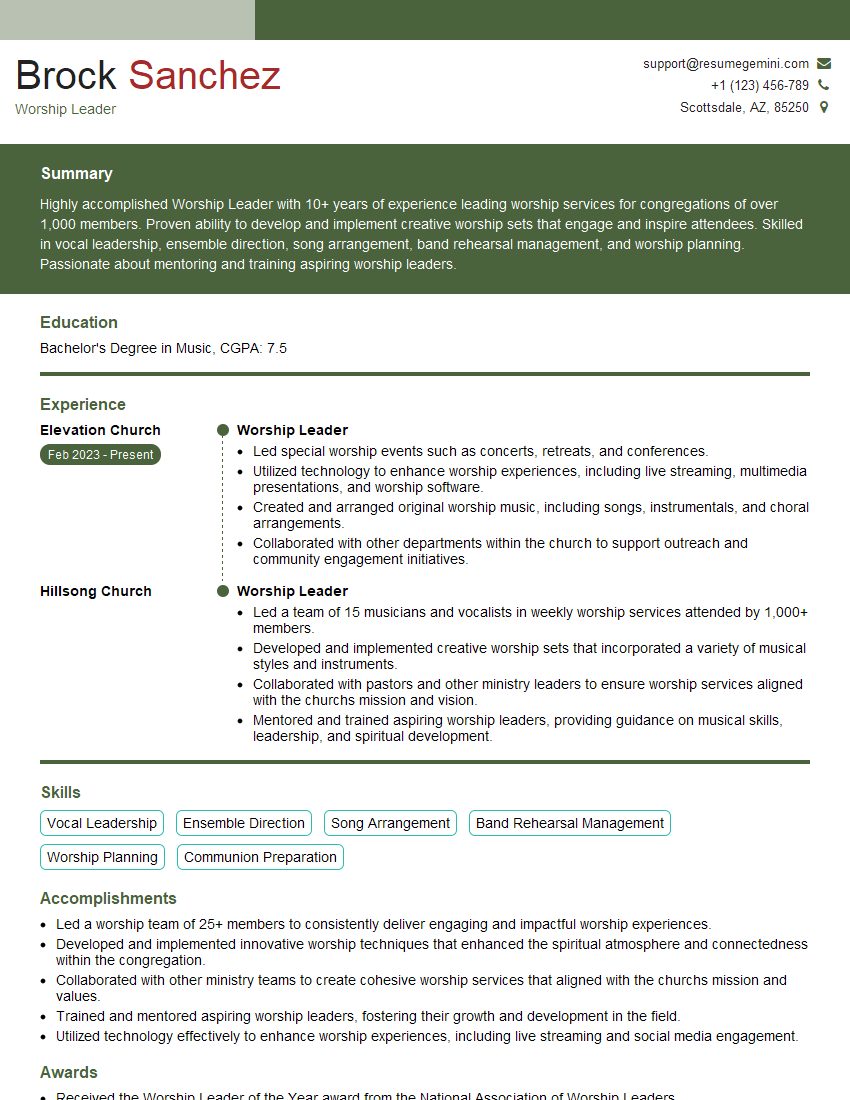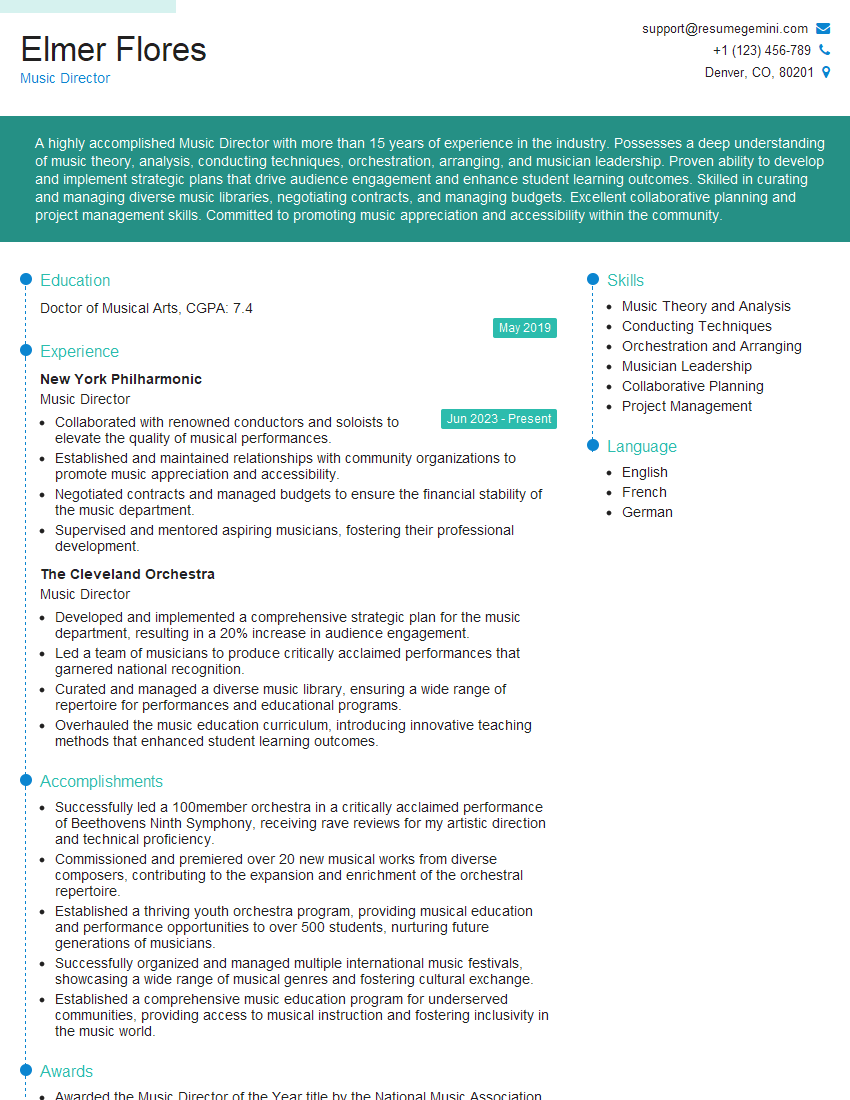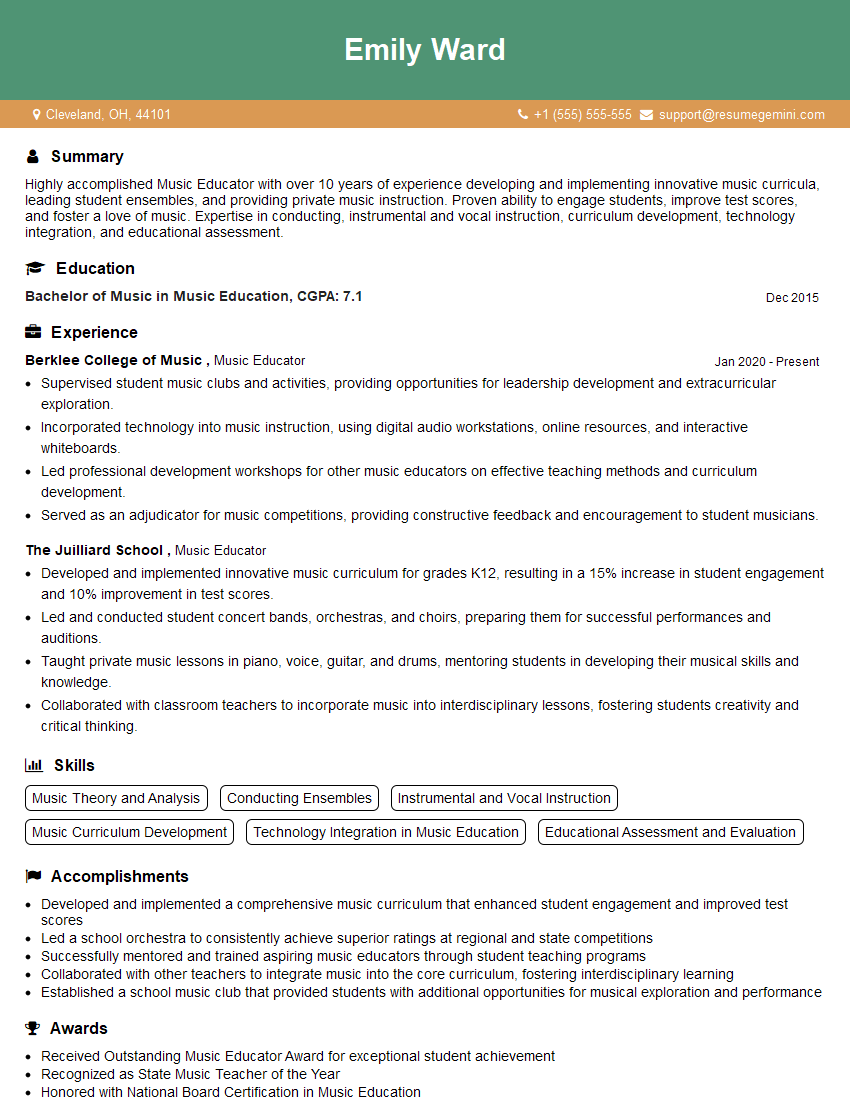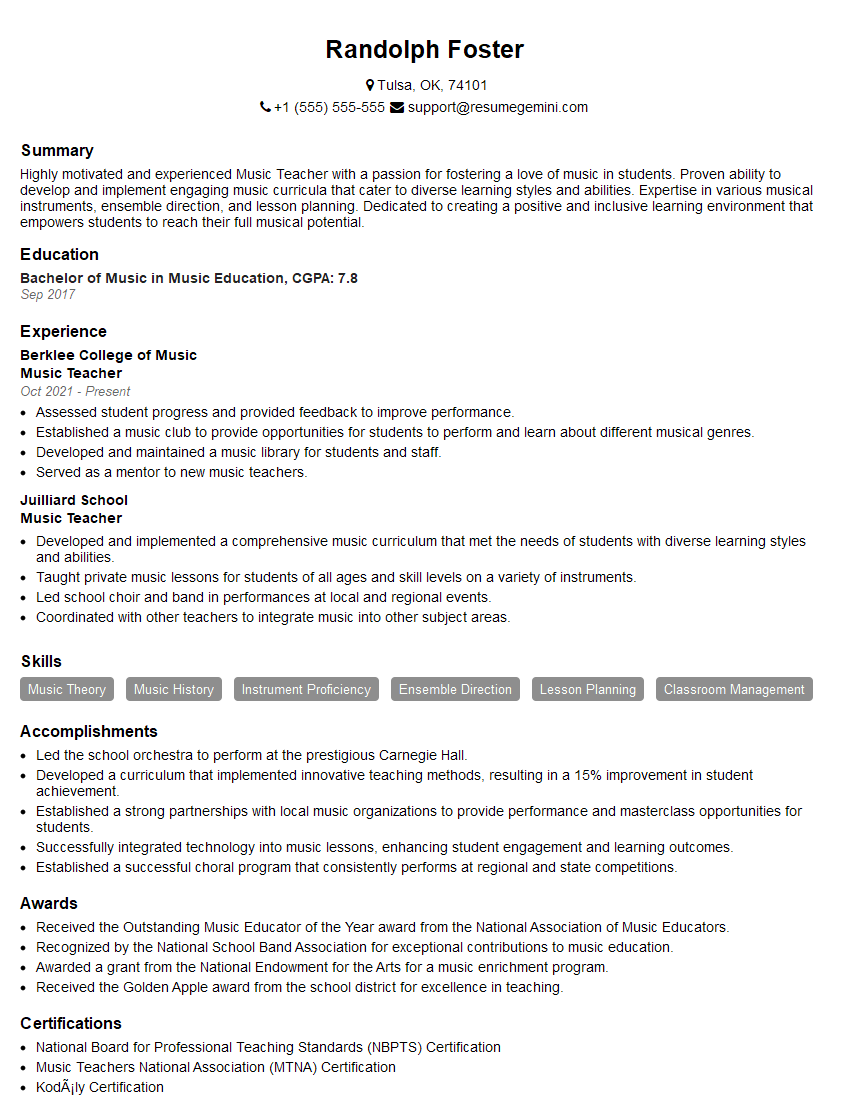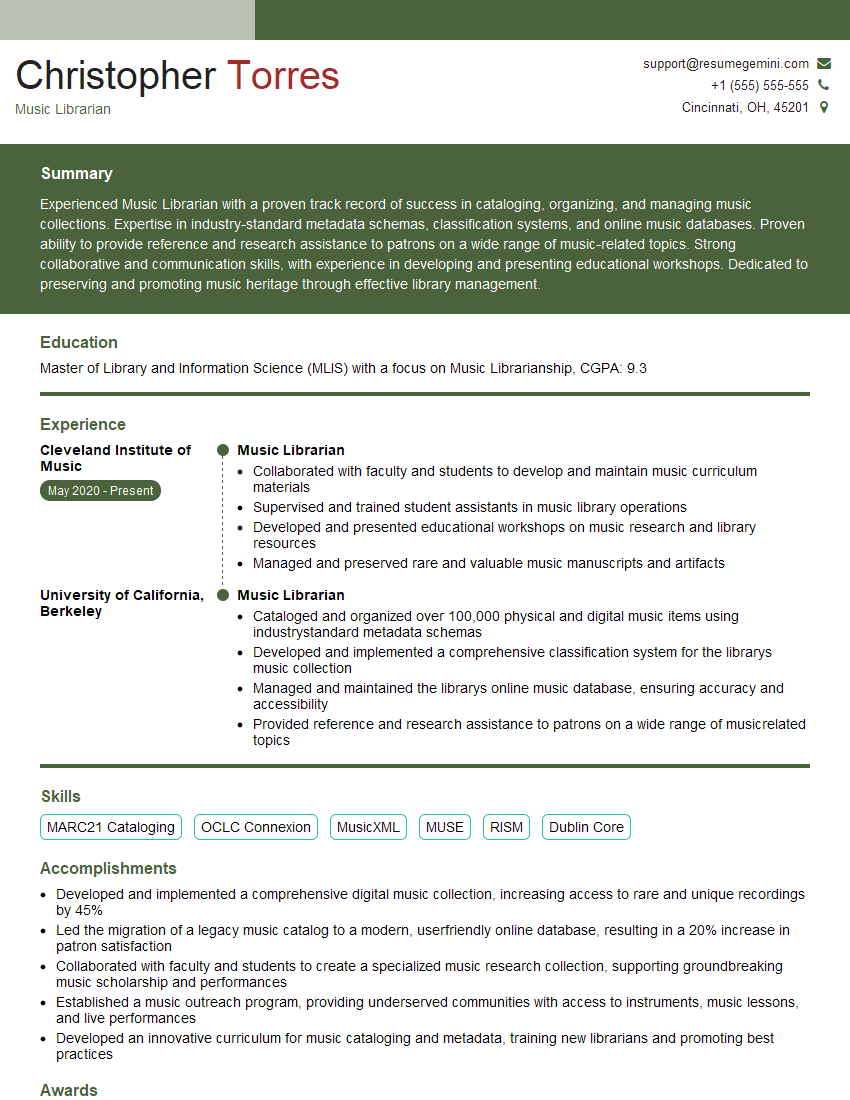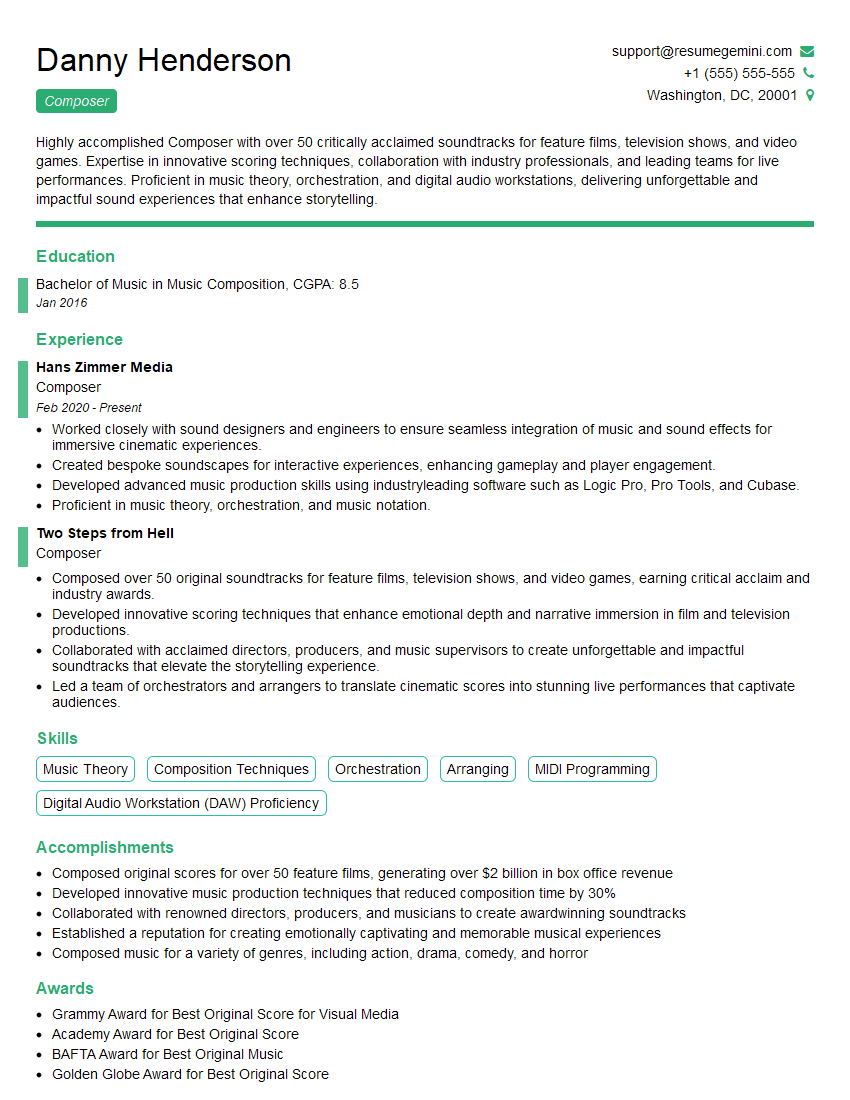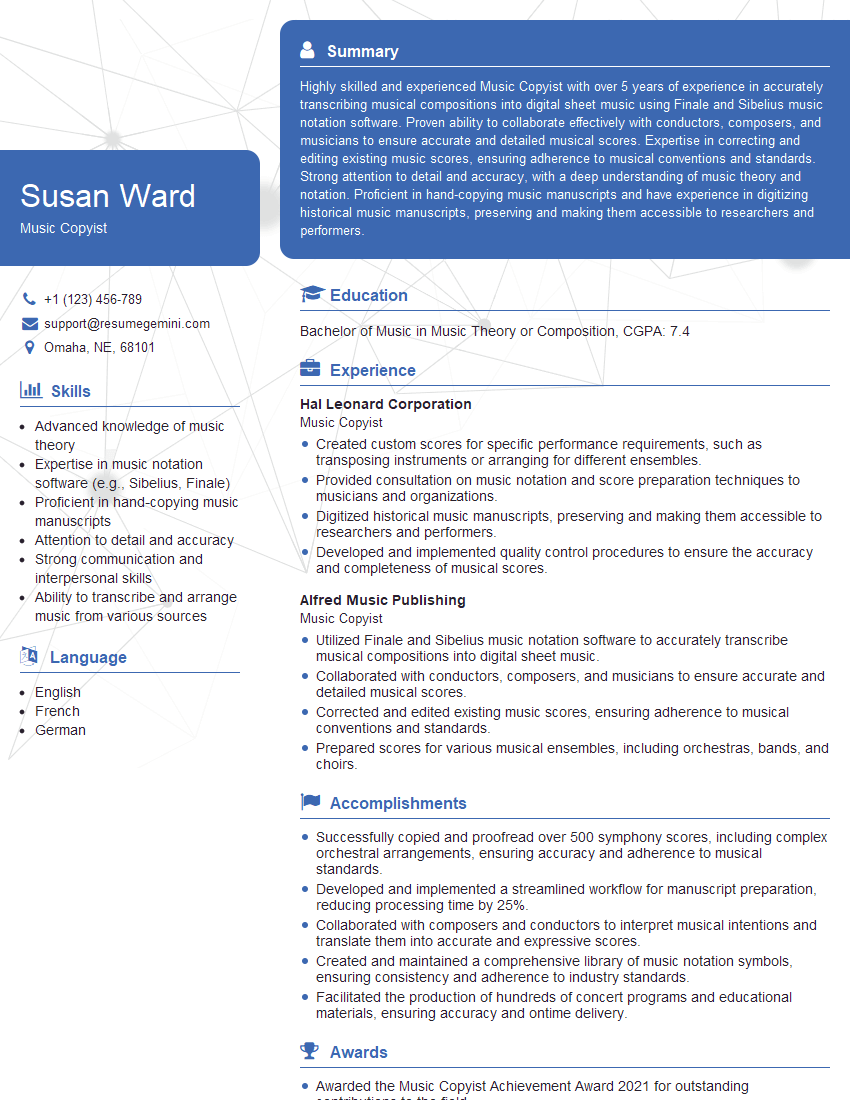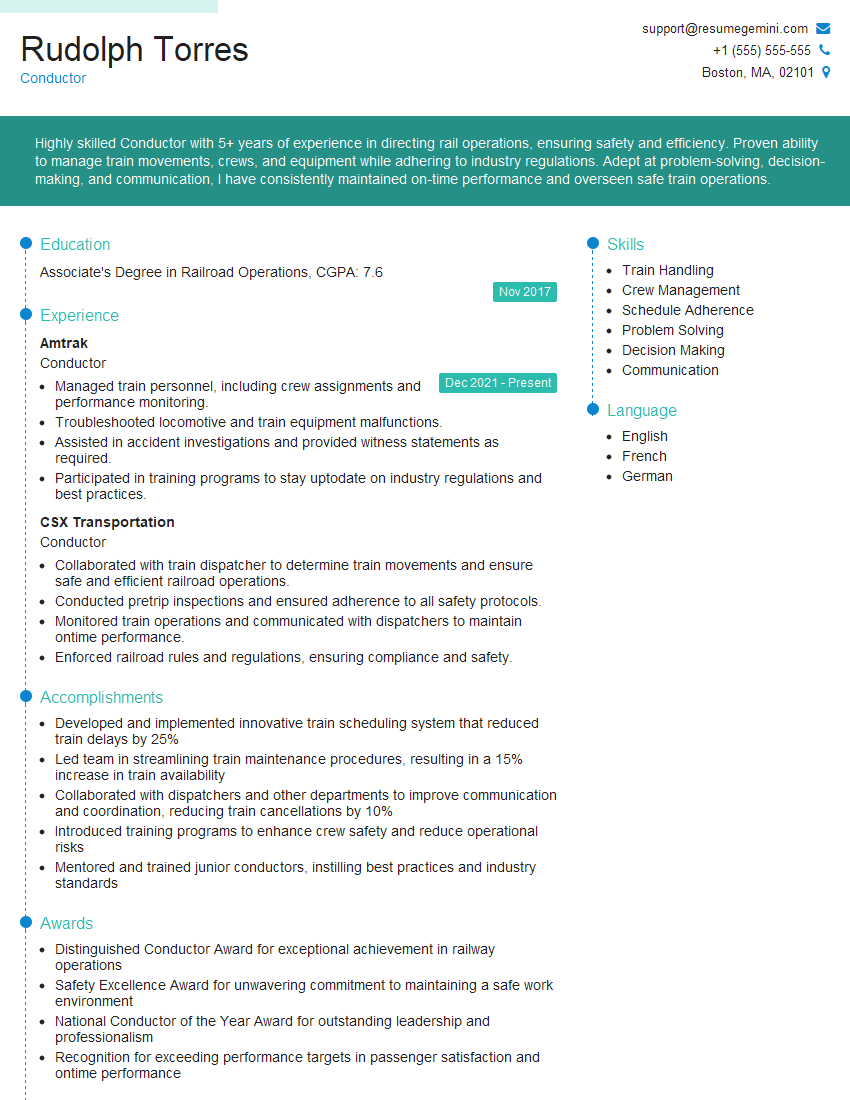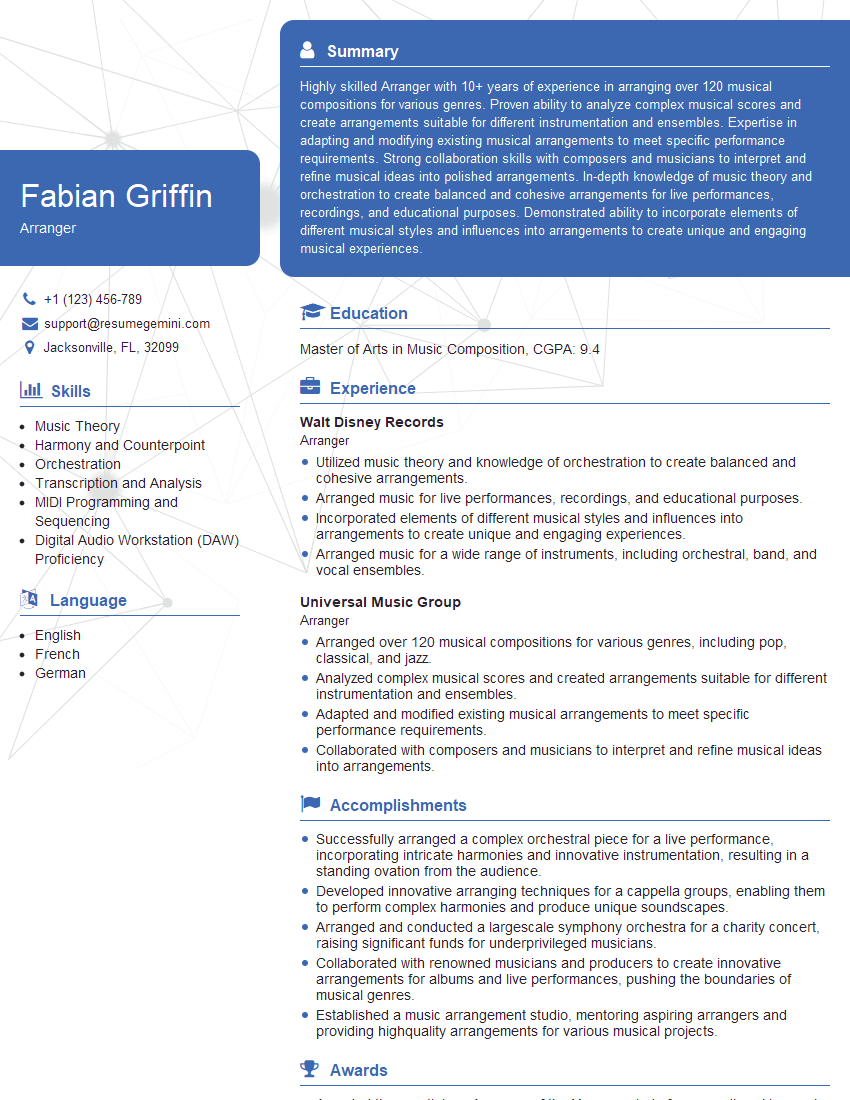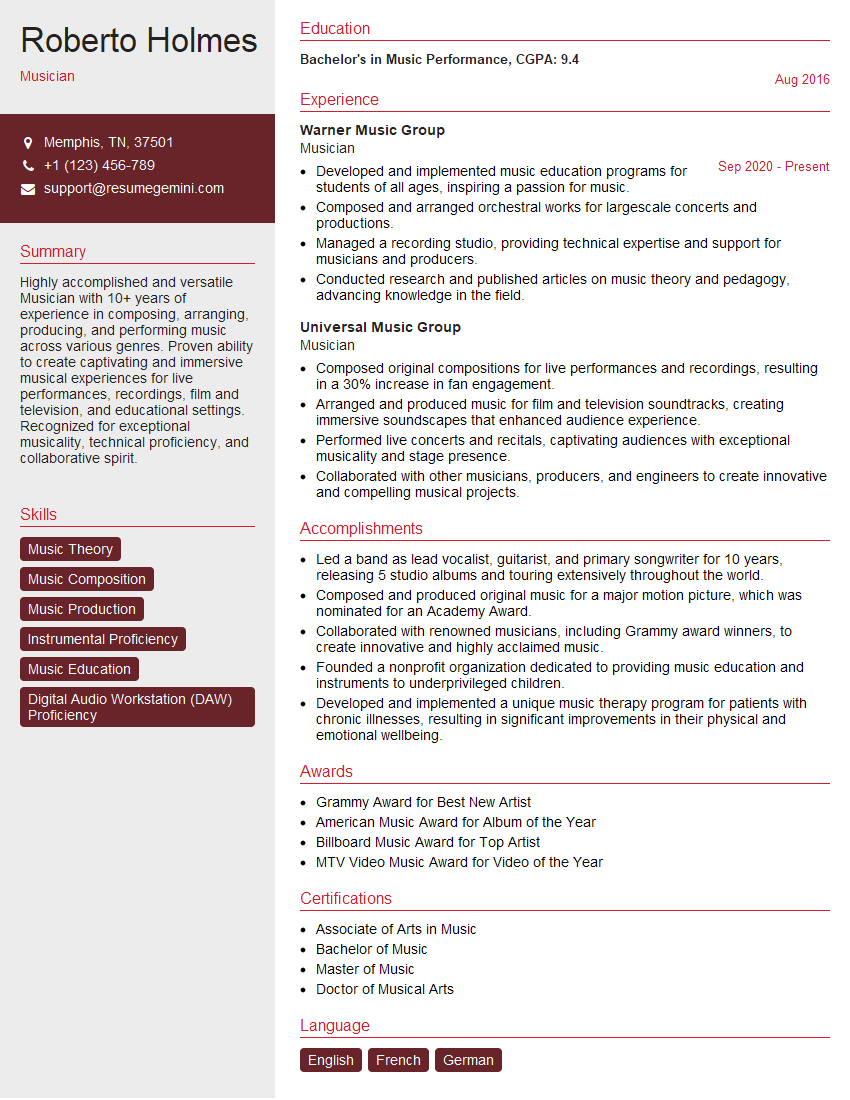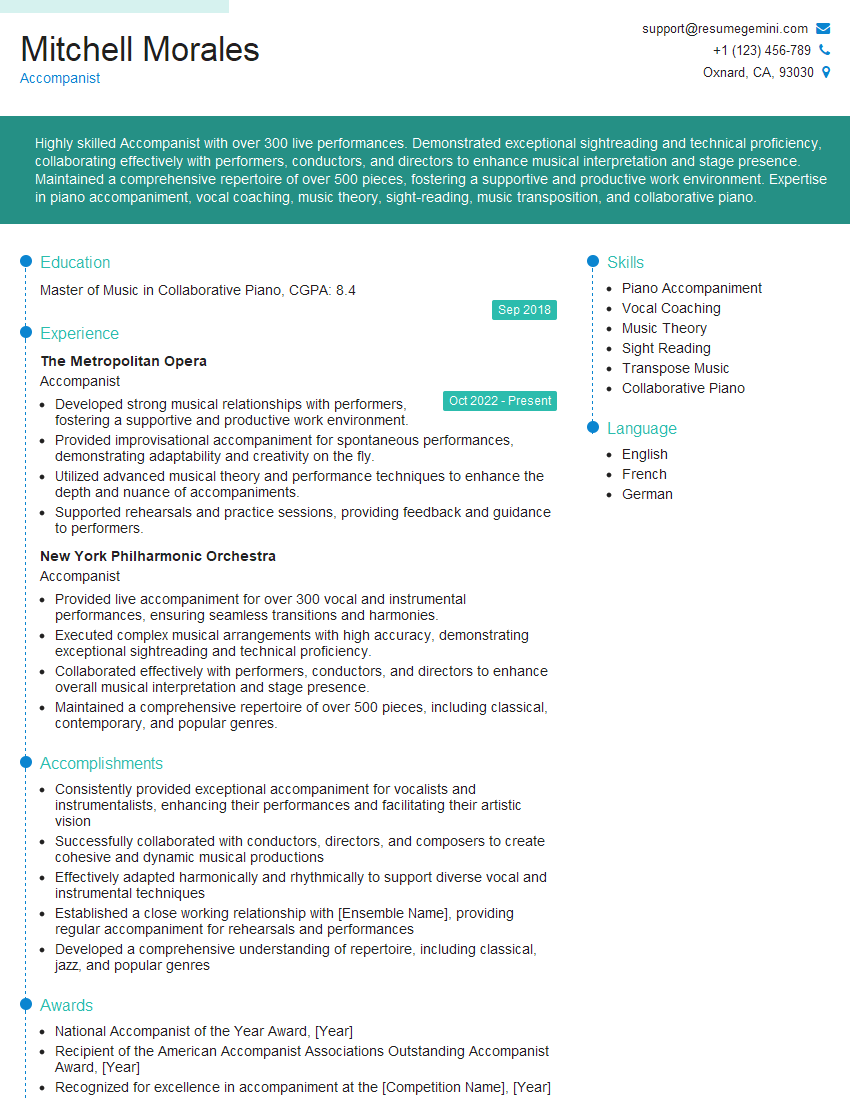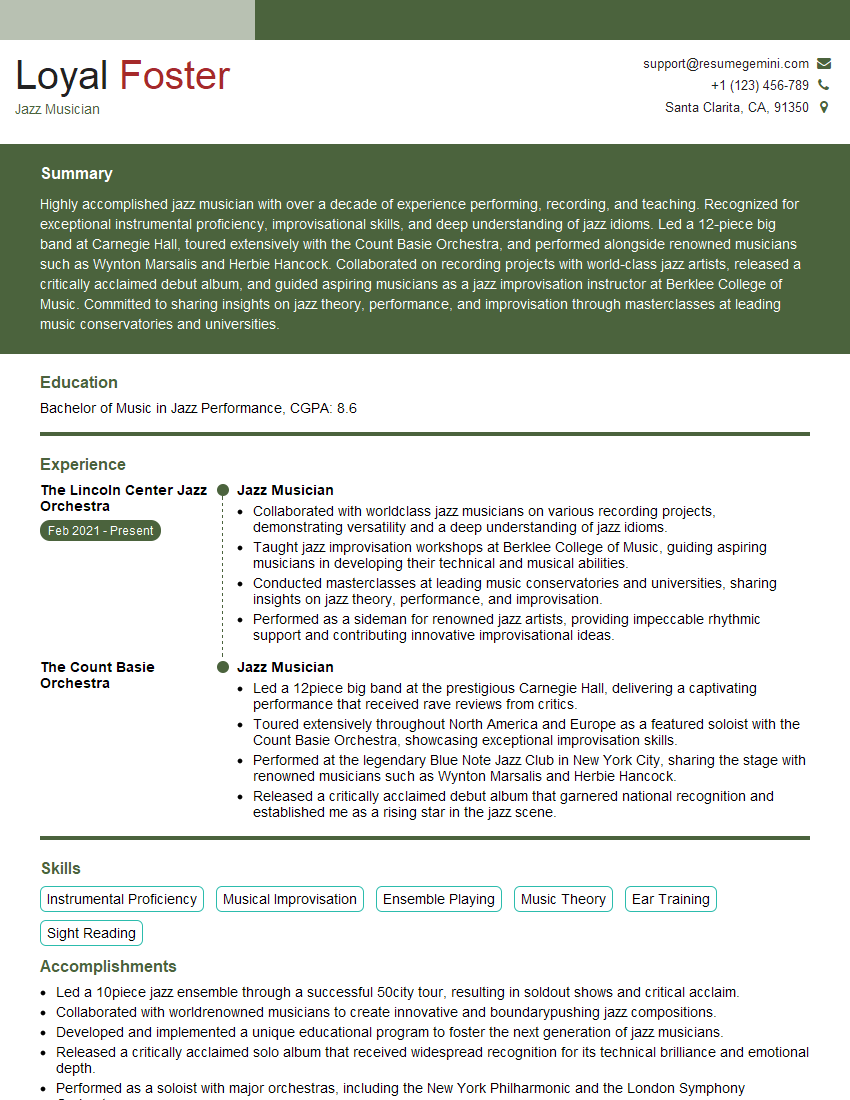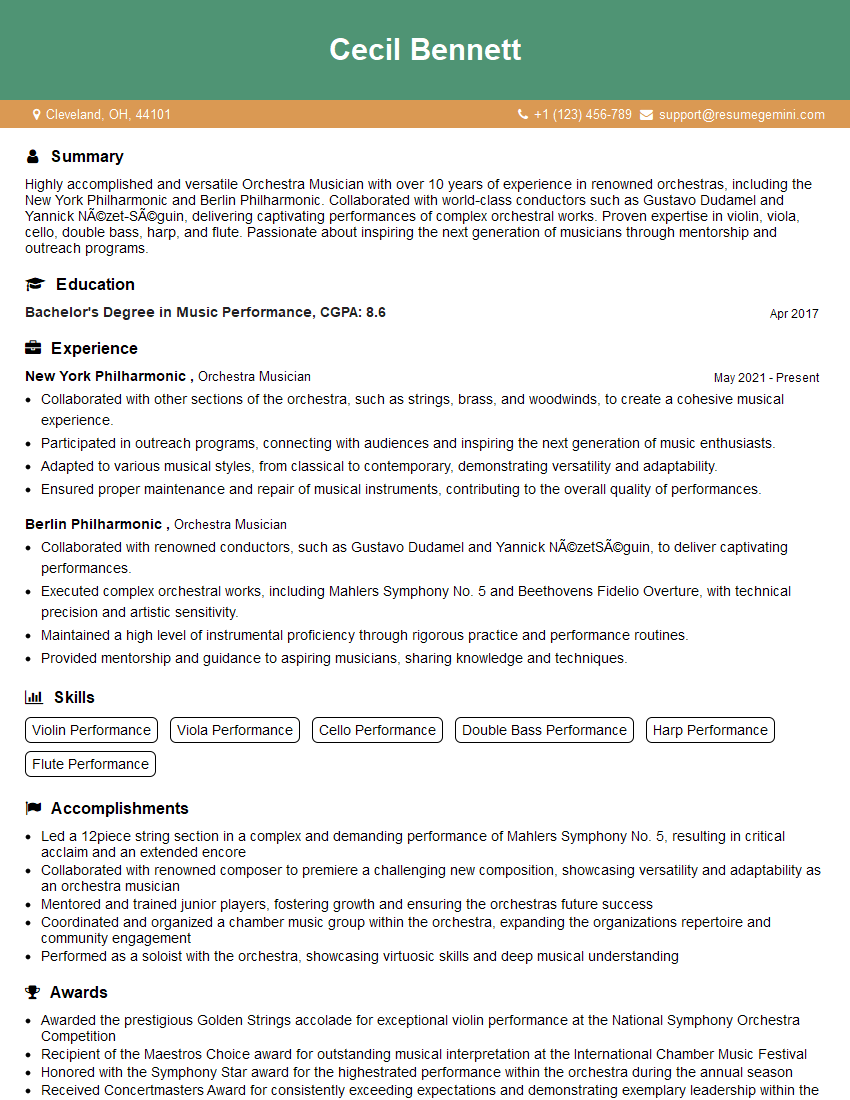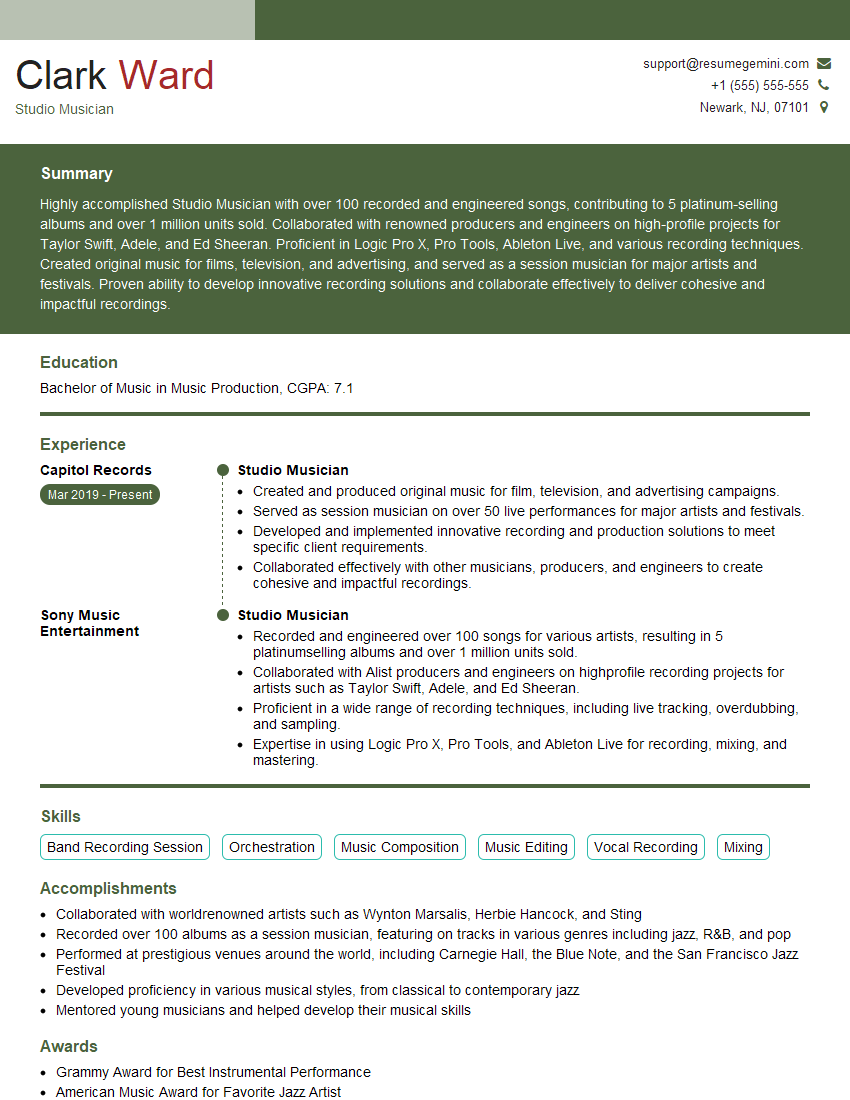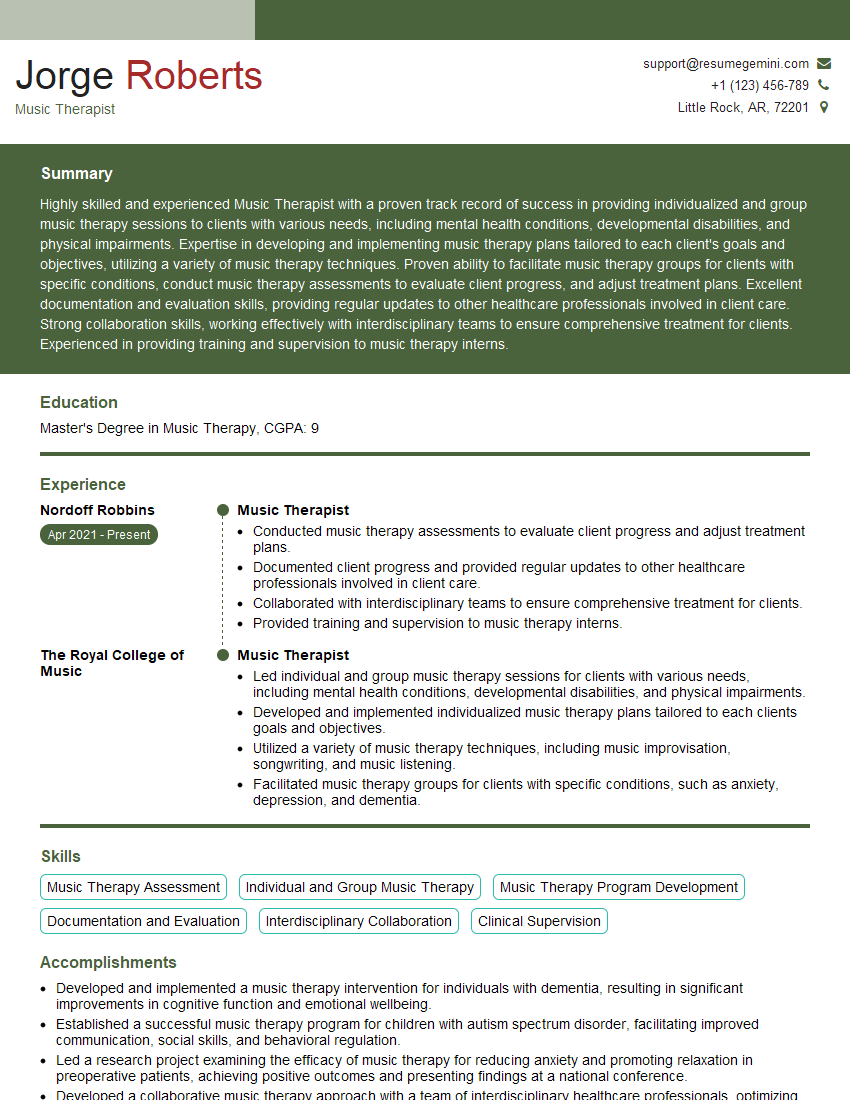Interviews are opportunities to demonstrate your expertise, and this guide is here to help you shine. Explore the essential Sight-Reading and Improvisation interview questions that employers frequently ask, paired with strategies for crafting responses that set you apart from the competition.
Questions Asked in Sight-Reading and Improvisation Interview
Q 1. Describe your approach to sight-reading unfamiliar musical scores.
My approach to sight-reading prioritizes a holistic understanding, not just note-reading. I begin with a quick overview of the piece, scanning for key elements like time signature, key signature, and overall form. This gives me a structural framework. Then, I focus on smaller sections, ‘chunking’ the music into manageable phrases. I try to anticipate the harmonic and melodic direction before actually playing, focusing on the overall contour rather than getting bogged down in individual notes initially. Think of it like reading a sentence – you don’t sound out each letter individually; you grasp the meaning of the words and phrases. Once I have a general understanding, I play through slowly and deliberately, correcting errors as I go. Regular practice with varied styles and levels of difficulty is key to developing efficient sight-reading skills.
For instance, if I encounter a piece in a minor key with a lot of chromaticism, I’ll mentally map out the harmonic progressions to better anticipate the melodic lines and avoid getting lost in the harmonic complexities. This preemptive analysis dramatically reduces the chances of stumbling.
Q 2. Explain your process for analyzing a piece of music for improvisation.
Analyzing a piece for improvisation involves a deeper dive than sight-reading. I start by identifying the harmonic structure: what chords are used, how they progress, and what their function is within the piece. I listen for the melodic motifs or rhythmic patterns that define the piece’s character. This provides a melodic and rhythmic vocabulary I can use in my improvisation. I also consider the style of music; blues improvisation differs significantly from classical improvisation, for example. Identifying the key, mode, and tempo is also crucial for establishing a framework for improvisation that fits the piece.
Let’s say I’m improvising over a blues in E. I’d identify the dominant seventh chords (E7, A7, B7) and focus on using blues scales (E blues scale, for example) and common blues licks, embellishing them according to the harmonic movement. The rhythmic phrasing would also be heavily influenced by the rhythmic feel established by the piece itself. Understanding the context is crucial for creating a meaningful and integrated improvisation.
Q 3. How do you handle sight-reading challenging rhythms or complex harmonies?
Challenging rhythms and complex harmonies require a more deliberate and analytical approach. For rhythms, I break down complex rhythmic patterns into smaller, simpler units. I often use rhythmic subdivisions (e.g., dividing a triplet into three sixteenth notes) to help me understand the relationship between the notes. For harmonies, I analyze the chord progressions and voice leading to grasp the overall harmonic direction. Understanding the function of each chord within the progression is key; for example, a dominant seventh chord typically leads to a tonic chord. I practice regularly with exercises focusing specifically on these elements, gradually increasing the complexity.
Imagine a piece with sextuplets. Instead of trying to play them as a single unit, I’d break them down into groups of three eighth notes, then practice those until they feel natural before combining them back into sextuplets. Similarly, complex harmonies are simplified by understanding the root movement and the inversions of each chord.
Q 4. Discuss your strategies for improvising within different musical styles.
My approach to improvisation varies drastically depending on the musical style. In jazz, I might use scales, arpeggios, and chord tones associated with that specific style, employing techniques like call-and-response or rhythmic displacement. Classical improvisation often involves ornamentation of existing melodies or creating variations on a theme within the established harmonic framework. In world music, I would research the scales and modes specific to the given musical culture, employing their characteristic rhythms and melodic patterns.
For example, improvising in bebop would require a strong understanding of chord substitutions and altered dominant chords, alongside fast melodic lines and complex rhythmic phrasing. In contrast, improvising in a Baroque style would involve more restrained ornamentation and a focus on contrapuntal textures within the context of established harmonic conventions.
Q 5. How do you maintain accuracy and musicality while sight-reading?
Maintaining accuracy and musicality during sight-reading is a balance of technical proficiency and musical sensitivity. Technical accuracy comes from regular practice and attention to detail; I focus on clear articulation, precise fingerings, and consistent rhythm. Musicality is about conveying the expression and emotion of the piece. This involves understanding phrasing, dynamics, and articulation markings. I practice sight-reading with a metronome to improve rhythmic accuracy and regularly record myself to identify areas for improvement in both technique and expression.
A good analogy is a skilled athlete—they train rigorously to master the technical aspects of their sport, but the artistry comes from their ability to integrate those technical skills with a compelling performance.
Q 6. Explain your method for developing melodic and harmonic improvisations.
Developing melodic and harmonic improvisations is a process of learning and internalizing musical vocabulary. This involves learning scales, modes, chord progressions, and rhythmic patterns. I actively listen to master improvisers in various styles, analyzing their phrasing, harmonic choices, and rhythmic ideas. I also compose short melodic and harmonic exercises to practice different improvisational techniques. A crucial aspect is the development of a strong ear—the ability to hear and internalize musical ideas and instantly transpose them.
For melodic development, I might start by creating a simple melodic motif and then develop it by varying its rhythm, adding ornamentation, or changing its contour. For harmonic development, I focus on chord progressions that create a sense of harmonic motion and tension-resolution. Regular practice and experimentation are essential to develop fluency and creativity in improvisation.
Q 7. How do you adapt your sight-reading technique based on different musical contexts?
My sight-reading technique adapts significantly based on the musical context. When sight-reading a complex orchestral score, I prioritize understanding the overall structure and my role within the ensemble. I focus less on detailed interpretation in the initial reading and more on accurately playing my part in relation to the other instruments. In a solo performance, however, I pay much closer attention to the nuances of the score, dynamics, and phrasing to create a personal interpretation. Similarly, sight-reading jazz charts requires a quick grasp of the chord changes and a readiness to improvise. Adaptability and flexibility are crucial; a rigid approach is detrimental to effective sight-reading in diverse musical situations.
For example, sight-reading a Bach prelude requires a different approach compared to a contemporary jazz piece. The Bach prelude demands a meticulous attention to detail, perfect articulation and adherence to the Baroque style. The jazz chart, on the other hand, requires a strong improvisational foundation and a fluid approach to the given harmony.
Q 8. How do you incorporate rhythmic variations into your improvisations?
Incorporating rhythmic variations into improvisation is crucial for creating musical interest and avoiding monotony. It’s about thinking rhythmically, not just melodically. I approach this by consciously manipulating the pulse and employing several techniques.
Syncopation: Accenting off-beats creates a sense of surprise and drive. For example, instead of playing a simple quarter note-quarter note rhythm, I might play an eighth note, dotted eighth note, creating a subtle yet effective syncopation.
Polyrhythms: Layering different rhythmic patterns simultaneously adds complexity and texture. This could involve playing a triplet rhythm against a duplet rhythm, for example. This requires careful planning and a strong sense of internal timing.
Rhythmic displacement: Shifting rhythmic motives around within a phrase alters the feel and creates unexpected melodic phrasing.
Rubato: Allowing the tempo to fluctuate slightly, subtly speeding up and slowing down, can add expressiveness and emotion. This technique is especially effective in ballads or more lyrical improvisations.
Ultimately, it’s about actively listening to the underlying rhythmic structure and finding creative ways to deviate from it without losing the overall groove. I often practice rhythmic exercises, focusing on feeling the rhythmic pulse in different meters and time signatures.
Q 9. Describe your process for incorporating stylistic elements into your improvisations.
Incorporating stylistic elements into my improvisations is about channeling the essence of a particular genre or composer. It’s not just about mimicking; it’s about understanding the underlying principles and applying them creatively. My process involves several steps:
Deep Listening: I immerse myself in the music of the chosen style. This involves active listening, identifying characteristic melodic contours, rhythmic patterns, harmonic progressions, and even characteristic articulations.
Identifying Key Characteristics: I break down the style into its constituent elements. For example, if I’m improvising in the style of Charlie Parker, I’ll focus on his characteristic use of bebop scales, fast tempos, and complex rhythmic phrasing. Similarly, for a blues improvisation, I’d focus on the blues scale, the characteristic blues progression, and the use of bends and slides.
Application and Adaptation: I then consciously incorporate these elements into my improvisation, always striving for a natural and expressive sound. This requires a high level of technical proficiency and a strong understanding of music theory. I rarely directly copy phrases; instead, I internalize the style’s essence and let it inform my improvisation. This means that while some stylistic elements might be present, the resulting improvisation remains original and uniquely mine.
Experimentation and Refinement: I constantly experiment with different ways to integrate the stylistic elements, refining my approach based on what sounds best and authentic.
Think of it like learning a new language – I’m not just memorizing words but understanding the grammar, syntax, and idioms to speak fluently.
Q 10. How do you handle unexpected changes or challenges during sight-reading?
Unexpected changes during sight-reading require quick thinking and adaptability. My approach relies on a combination of preparation, flexibility, and problem-solving skills.
Preparation: Thorough preparation is key. I always preview the piece beforehand, noting any unusual key signatures, time signatures, or harmonic progressions. This helps me anticipate potential challenges.
Flexibility: When an unexpected change occurs (a sudden modulation, a tricky rhythmic passage), I focus on maintaining the overall flow and phrasing, even if I have to make minor adjustments on the fly. I try to understand the harmonic context and adjust accordingly, maintaining a logical progression.
Problem-Solving: I might simplify complex passages temporarily, focusing on the harmonic structure rather than exact note values. I’ll often “chunk” the music into smaller, manageable sections. This allows me to quickly grasp the structure and make informed decisions about how to navigate difficult passages.
Recovery: If a significant error occurs, I aim for a smooth and inconspicuous recovery, rather than drawing attention to the mistake. Practicing sight-reading regularly helps build the resilience and confidence needed to handle such situations gracefully.
Sight-reading is akin to navigating an unfamiliar route; a map (preparation) provides direction, but the ability to adjust to unexpected detours (flexibility) is vital to reach the destination smoothly.
Q 11. How do you maintain fluency and expression while improvising?
Maintaining fluency and expression during improvisation is a continuous process of refinement. It involves both technical skill and musicality.
Technical Proficiency: Strong technical skills are essential for maintaining fluency. This includes scales, arpeggios, and chord voicings, allowing me to quickly and easily access appropriate melodic ideas.
Phrasing and Articulation: Careful attention to phrasing is vital for musical expression. I use varied articulations (legato, staccato, etc.) and dynamic shading to shape musical phrases and convey emotion. Improvisation isn’t just about the notes; it’s about how they’re played.
Listening and Responding: I actively listen to what I’m playing, and adjust accordingly. Does the phrase need more energy? A softer touch? A change in rhythmic feel? Constant internal dialogue keeps the improvisation fresh and alive.
Creativity and Spontaneity: While preparation is important, I leave room for spontaneity. Unexpected musical ideas that emerge during the improvisation add unique character and prevent the performance from becoming formulaic.
The key is to achieve a balance between technical mastery and emotional expression. It’s a blend of structured preparation and impulsive creativity.
Q 12. Explain your approach to learning new musical material quickly.
Learning new musical material quickly requires a structured approach that combines efficient strategies with a deep understanding of music theory.
Analyze the Structure: I begin by analyzing the overall structure of the piece. This includes identifying the form (e.g., sonata form, theme and variations), harmonic progressions, and melodic motifs.
Chunking: I break the piece into smaller, manageable sections, focusing on mastering each section before moving on to the next. This prevents feeling overwhelmed.
Identify Key Passages: I focus on memorizing key passages and harmonic changes. I might use mnemonics or other memory aids to aid in retention. I prioritize understanding the harmonic structure above rote memorization of every single note.
Practice Strategically: I practice in different ways: slowly, at tempo, with a metronome. I pay attention to problem areas, practicing them repeatedly and progressively increasing the speed until they are solid. A slow, accurate rendition is preferable to a fast one that is error-ridden.
Record and Listen Back: I record my practice sessions to identify areas for improvement and track my progress. This allows for objective evaluation and focused practice.
Learning new material quickly requires efficient strategies and a commitment to regular, focused practice. It’s not about speed; it’s about intelligent practice and effective memory techniques.
Q 13. Discuss your experience with sight-reading in ensemble settings.
Sight-reading in ensemble settings presents unique challenges that require strong listening skills and adaptability. It goes beyond individual proficiency; it’s about collaborative musicianship.
Active Listening: In an ensemble, active listening is paramount. I constantly monitor my fellow musicians, ensuring that my part blends well with the overall sound. This involves being sensitive to dynamics, tempo, and phrasing.
Blending and Balance: I pay close attention to the overall balance within the ensemble, ensuring my part is neither too loud nor too quiet. It is about contributing to the unified sonic texture.
Flexibility and Adjustment: I am prepared to make subtle adjustments to my playing in response to the other musicians’ interpretations. This might involve slight adjustments in tempo or dynamics to maintain coherence.
Communication: Clear communication with other musicians is crucial, particularly when encountering difficulties. Non-verbal cues and pre-performance discussions can resolve potential issues before they arise.
Sight-reading in ensembles demands a high degree of professionalism and musical sensitivity. It’s less about individual virtuosity and more about collaborative artistry.
Q 14. How do you incorporate audience interaction into your improvisations?
Incorporating audience interaction into improvisation can greatly enhance the performance. It’s about creating a dynamic exchange and building a connection.
Responding to the Energy: I am sensitive to the energy of the audience. A lively audience might warrant a more energetic improvisation, while a quieter audience might call for a more introspective approach.
Call and Response: Simple call and response elements can be incorporated. This could involve creating a melodic phrase that the audience intuitively responds to, mirroring the phrase back in some way.
Theme Selection: Choosing a theme or starting point that resonates with the audience can also build a connection. A well-known melody or a familiar harmonic progression can create a shared experience.
Direct Engagement (with caution): In some cases, direct engagement with the audience, such as asking for a rhythmic suggestion or a melodic idea, can be fun. However, this needs to be carefully integrated and must not disrupt the flow of the improvisation. It works best with a receptive and interactive audience.
Audience interaction is a double-edged sword. While it can enhance a performance, it also requires sensitivity and awareness of the audience’s receptiveness. It’s about creating a dialogue with the audience, not forcing a response.
Q 15. How do you maintain a balance between creativity and technical precision in improvisation?
Balancing creativity and technical precision in improvisation is like being a tightrope walker: you need both artistry and stability. Technical precision provides the foundation – a strong grasp of harmony, rhythm, and melody – ensuring your improvisations are coherent and well-structured. Creativity, on the other hand, is the daring leap, the unexpected twist that makes it engaging and unique. It’s about exploring unexpected melodic turns, harmonic shifts, or rhythmic variations within that stable framework.
I achieve this balance through diligent practice. Scales, arpeggios, and chord studies build the technical base. Then, I intentionally experiment with different approaches during improvisation sessions. For instance, I might start with a simple melodic idea and gradually embellish it with chromatic passing tones, or invert chords to create unexpected harmonic colours, all while keeping the rhythmic structure intact. This constant interplay of structured practice and free exploration allows for both technical mastery and creative expression.
Career Expert Tips:
- Ace those interviews! Prepare effectively by reviewing the Top 50 Most Common Interview Questions on ResumeGemini.
- Navigate your job search with confidence! Explore a wide range of Career Tips on ResumeGemini. Learn about common challenges and recommendations to overcome them.
- Craft the perfect resume! Master the Art of Resume Writing with ResumeGemini’s guide. Showcase your unique qualifications and achievements effectively.
- Don’t miss out on holiday savings! Build your dream resume with ResumeGemini’s ATS optimized templates.
Q 16. Describe a situation where you had to sight-read challenging music under pressure.
During a live performance with a new chamber orchestra, the conductor unexpectedly presented me with a very complex piece I’d never seen before. The score was dense, with rapid tempo changes and intricate counterpoint. The pressure was intense; the orchestra was ready, and I was on the spot.
My immediate focus was on quickly assessing the piece’s key signature, time signature, and overall structure. I scanned the score for particularly challenging passages, such as complex rhythmic patterns or sudden shifts in dynamics. I prioritized accuracy over embellishment, aiming to get the notes correctly in place and conveying the intended phrasing as faithfully as possible. While some aspects were inevitably rough around the edges given the time constraints, the result was surprisingly well-received thanks to a focus on the overall architecture of the composition and conveying the emotional arc.
Q 17. How do you identify and address technical difficulties encountered during sight-reading?
Encountering technical difficulties during sight-reading is inevitable. My approach involves a multi-pronged strategy. First, I immediately identify the source of the problem. Is it a complex rhythmic pattern? An unfamiliar key signature? A tricky intervallic leap? Once identified, I apply targeted solutions.
- Rhythmic difficulties are tackled by breaking down complex rhythms into smaller, manageable units. I might clap or tap the rhythm before playing, ensuring a solid internal rhythmic framework.
- Unfamiliar key signatures require a quick mental map of the relevant scales and chords to correctly navigate the passage. I might quickly sketch out a relevant scale on my music manuscript or mental note before proceeding.
- Tricky intervals are addressed by carefully finger placement or using visual cues to aid in proper intervallic identification. I also try to understand the melodic context to smoothly navigate the passage.
Beyond immediate solutions, addressing consistent weaknesses requires focused practice. If I consistently struggle with certain rhythmic patterns, I will incorporate exercises tailored to those specific challenges into my practice routine.
Q 18. How do you develop musical ideas spontaneously during improvisation?
Spontaneous musical idea generation during improvisation is like building with LEGOs. You start with basic blocks – scales, chords, rhythmic motifs – and then creatively assemble them into something new and exciting. It’s a process of continuous listening, reacting, and building.
I usually begin by listening carefully to the harmonic context established by the other musicians. This provides a foundation for melodic and harmonic development. I might pick out a motive from their melody to use as a starting point for a solo improvisation. I then experiment with different rhythmic variations, melodic ornamentation, and harmonic extensions to develop the initial idea. Sometimes, I will deliberately introduce a contrasting idea to create tension and release. This iterative process of listening and responding is what allows for genuine spontaneity and creativity within an established structure.
Q 19. Explain your understanding of musical theory’s role in sight-reading and improvisation.
Musical theory is the roadmap for both sight-reading and improvisation. In sight-reading, theory provides the framework for understanding the notation. Understanding key signatures, time signatures, chord progressions, and melodic structures allows for a much smoother decoding of the musical score.
In improvisation, theory becomes the toolbox. Knowledge of scales, modes, chord voicings, and harmonic relationships provides the vocabulary for creating coherent and interesting musical ideas. Understanding harmonic function allows for effective transitions and creating musical tension and release. For example, understanding the dominant-tonic relationship lets me smoothly resolve musical phrases and create a sense of closure. A strong theoretical understanding ensures the improvisations are not just random notes, but meaningful musical statements.
Q 20. How do you manage stage fright or performance anxiety during sight-reading or improvisation?
Managing stage fright or performance anxiety, especially during sight-reading or improvisation, requires a multifaceted approach. Preparation is key; thorough rehearsal helps build confidence. However, even with preparation, anxiety can arise. I employ several techniques. Deep breathing exercises help to calm the nerves and centre my focus. Visualization – mentally rehearsing the performance successfully – can also be incredibly effective. Moreover, I remind myself that mistakes are part of the creative process, and even small imperfections won’t necessarily ruin the performance.
Focusing on the music itself, rather than the audience’s reaction, is crucial. I try to connect with the emotions conveyed in the piece, channeling my energy into expressing those feelings through my playing. The connection to the music helps mitigate the pressure and anxiety associated with the performance itself. Finally, past successful performances serve as positive reinforcement and build confidence for future challenges.
Q 21. Discuss your ability to adapt your improvisation to match the style of other musicians.
Adapting my improvisation to match the style of other musicians involves active listening and a willingness to step outside my usual comfort zone. I pay close attention to their phrasing, rhythmic choices, and harmonic language. If they’re playing in a bluesy style, I’ll incorporate blues scales and appropriate rhythmic figures into my solo. If they’re playing something more classical, my phrasing and articulation will reflect that style.
It’s also about being a good listener, anticipating their musical ideas, and responding appropriately. I might mirror their melodic contours, or use their rhythmic ideas as a basis for my own. This interaction is what truly brings life to a collaborative improvisational experience. It’s less about imposing my style, and more about weaving my musical voice into the existing musical conversation.
Q 22. How do you use harmonic analysis to inform your improvisations?
Harmonic analysis is the cornerstone of effective improvisation. It’s the process of understanding the underlying harmony of a piece – the chords, their relationships, and how they progress. In improvisation, I use harmonic analysis to guide my melodic choices, ensuring that my phrases complement and enhance the existing harmony rather than clashing with it.
For instance, if a piece is in C major and the chord progression is Cmaj7 – Fmaj7 – G7 – Cmaj7, I’ll identify the notes within each chord (C, E, G, B for Cmaj7; F, A, C, E for Fmaj7, etc.). My improvisations will then primarily utilize notes from these chords. I might also use chromatic passing tones or approach notes to create a more interesting melody, but always keeping the underlying harmony in mind. Understanding chord function (tonic, dominant, subdominant) allows me to create tension and release, mirroring the harmonic structure of the original piece. Ignoring the underlying harmony often leads to dissonant and unmusical improvisations.
I’ll also consider secondary dominants or borrowed chords to add unexpected twists, but always carefully choose my notes to resolve smoothly back to the main chord.
Q 23. Describe your familiarity with different improvisation techniques (e.g., scales, modes, chord progressions).
My improvisation techniques are quite varied, drawing from a broad understanding of music theory. I’m highly proficient in using scales and modes to generate melodic ideas. Scales, like major, minor, harmonic minor, and melodic minor, provide a framework for melodic construction, while modes (Ionian, Dorian, Phrygian, Lydian, Mixolydian, Aeolian, Locrian) offer different melodic flavors within a given key.
I also rely heavily on an understanding of chord progressions. Common progressions, such as ii-V-I or I-vi-IV-V, give structure to my improvisations, guiding the harmonic direction of my ideas. Knowing the implied harmonies within a progression allows me to construct solos that complement and enhance those progressions, creating a sense of unity and purpose.
Beyond these fundamental techniques, I incorporate other approaches like pentatonic scales for bluesy phrasing, altered dominant scales for adding color and tension, and even microtonal explorations depending on the context.
Q 24. How do you incorporate blues scales into your improvisations?
Blues scales are a powerful tool for improvising, especially in blues and jazz contexts. The blues scale, typically a pentatonic scale with a characteristic ‘blue note’ (a flattened 3rd or 5th), adds a distinctive soulful quality.
I use blues scales by focusing on their characteristic intervals. For example, in a 12-bar blues in E, I might use the E blues scale (E F# G A B D), focusing on the flattened 3rd (G) and flattened 5th (B) to create that iconic bluesy sound. I’ll also utilize blues licks and phrasing, which are common melodic figures that are heavily associated with the blues. I might incorporate these licks and adapt them to fit within the harmony and rhythm of the piece. To avoid sounding repetitive, I vary my rhythmic approach and articulation, and sometimes I’ll strategically use notes outside the blues scale for added interest and to resolve back into the blues scale for a satisfying conclusion.
Q 25. What are some common pitfalls to avoid in sight-reading and how do you mitigate them?
Sight-reading challenges often stem from a lack of preparation, poor rhythmic accuracy, or insufficient understanding of the notation itself. One common pitfall is rushing through the music without properly understanding the harmonic context, leading to awkward phrasing and inaccurate rhythms. Another is neglecting to identify key signatures and time signatures quickly, which can throw off pitch and rhythm almost immediately.
To mitigate these challenges, I emphasize preparation. Before starting, I quickly scan the piece to identify the key, time signature, and overall structure, including any unusual notation or rhythmic patterns. I focus on understanding the phrasing, paying close attention to articulation marks and dynamics. During sight-reading, I emphasize a steady tempo, carefully monitoring my rhythm to prevent rushing or lagging. If I encounter difficulties, I employ a ‘chunking’ method: breaking down complex sections into smaller, manageable phrases for gradual assimilation.
Consistent practice, a thorough understanding of music theory, and a systematic approach to reading music are essential for effective sight-reading.
Q 26. How do you practice sight-reading and improvisation to improve your skills?
My practice routine for sight-reading and improvisation is multifaceted and involves regular, focused sessions. For sight-reading, I work with progressively challenging pieces, starting with easier material to build confidence and gradually increasing the difficulty level. I use a metronome to maintain consistent tempo and to cultivate rhythmic accuracy. I focus on accurate note reading, articulation, and dynamics. Regular, even daily, practice, even if just for a short period, is crucial for improvement.
For improvisation, my practice includes exercises focused on melodic invention, harmonic exploration, and rhythmic variation. I use backing tracks, chord progressions, or lead sheets to improvise over. These exercises help me to develop my fluency, creativity, and ability to adapt to different harmonic contexts. I actively record my improvisations to self-critique, identifying areas for improvement in my technique, phrasing, and creativity.
I find that combining sight-reading and improvisation practice enhances both skills. Improvising over pieces I’ve sight-read helps me internalize the harmonic structure and improve my melodic phrasing. Conversely, sight-reading improvisational transcriptions improves my sight-reading skills and understanding of improvisation techniques.
Q 27. How familiar are you with different musical notations and their implications for sight-reading?
I’m familiar with various musical notations, including standard notation (staff notation), tablature (guitar tablature, etc.), and various forms of lead sheets. Understanding these different notations is essential for versatility. Standard notation provides a detailed representation of pitch and rhythm, vital for accurate sight-reading. Tablature is more instrument-specific, often used for guitar and other fretted instruments, and is usually more intuitive for those instruments.
The implications for sight-reading vary depending on the notation. Standard notation demands a higher level of theoretical understanding. Tablature is often more intuitive for the instrument but may lack the nuanced details found in standard notation, like dynamics, articulation, and sometimes even exact rhythms. Lead sheets, often focusing on chord changes, are invaluable in improvisation but may be insufficient for detailed sight-reading.
My familiarity with different notations allows me to adapt quickly to various musical scenarios and readily engage with different types of scores.
Q 28. Describe your experience in transcribing music by ear and its relation to improvisation.
Transcribing music by ear is a crucial skill, deeply intertwined with improvisation. It enhances my understanding of musical structure, phrasing, and harmonic choices. Transcribing forces me to listen attentively to the nuances of a performance, analyzing the melody, harmony, and rhythm. This deep listening cultivates a refined ear and a stronger sense of musicality.
The relationship between transcription and improvisation is synergistic. By transcribing solos or melodic lines, I gain insights into the techniques used by other musicians. I can then adapt and apply these techniques in my own improvisations. Transcribing also helps me understand how different musicians approach harmonic structures, resulting in richer and more versatile improvisations. For instance, transcribing a blues solo by B.B. King reveals his phrasing techniques and his unique approach to using the blues scale. This information informs and enriches my own improvisational approaches, building a broader understanding of blues vocabulary and phrasing.
Key Topics to Learn for Sight-Reading and Improvisation Interview
- Rhythm and Meter: Understanding complex time signatures, rhythmic notation, and syncopation. Practical application: Accurately reading and performing unfamiliar rhythms at various tempos.
- Melody and Harmony: Identifying melodic contours, chord progressions, and harmonic functions. Practical application: Analyzing a given musical passage to understand its structure and emotional impact.
- Key Signatures and Scales: Fluently recognizing and applying major, minor, and modal scales within different key signatures. Practical application: Quickly transposing melodies and improvising within a given key.
- Improvisational Techniques: Exploring scales, arpeggios, and chord voicings as a foundation for improvisation. Practical application: Creating melodic and harmonic solos that complement a given harmonic progression.
- Sight-Reading Strategies: Developing efficient eye-hand coordination and techniques for quickly deciphering musical notation. Practical application: Demonstrating the ability to perform unfamiliar music accurately and expressively at first sight.
- Musical Context and Style: Understanding stylistic nuances and interpreting musical notation within specific genres. Practical application: Adapting your performance approach to reflect the style of the piece.
- Problem-Solving in Sight-Reading: Identifying and correcting errors in real-time; applying analytical skills to overcome challenges in complex passages.
- Ear Training & Transposition: Developing the ability to quickly identify intervals, chords, and melodies by ear; transposing melodies between keys.
Next Steps
Mastering sight-reading and improvisation is crucial for a successful career in music. These skills demonstrate your musical proficiency and adaptability, opening doors to a wider range of opportunities. To increase your chances of landing your dream role, create a strong, ATS-friendly resume that highlights your accomplishments and skills. ResumeGemini is a trusted resource to help you build a professional and effective resume. We provide examples of resumes tailored to showcasing Sight-Reading and Improvisation skills, helping you present your qualifications in the best possible light.
Explore more articles
Users Rating of Our Blogs
Share Your Experience
We value your feedback! Please rate our content and share your thoughts (optional).
What Readers Say About Our Blog
good
